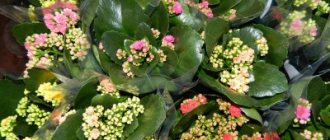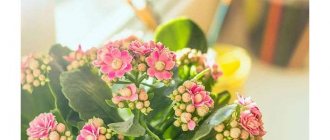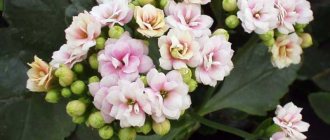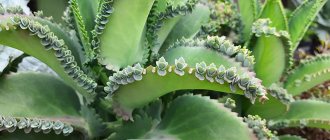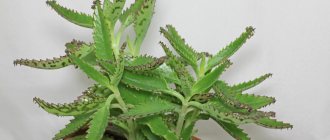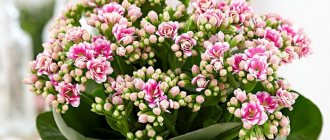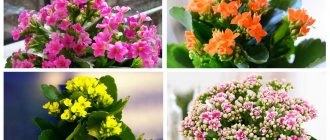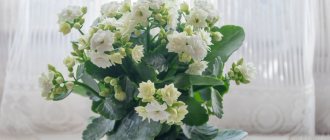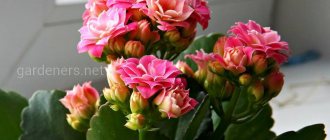The flower turns into a decorative, well-groomed bush. We pin it one last time when flowering is about to begin. Using this method, our Mix can bloom 2 times a year. To induce flowering of Kolanchoe Mix, a “dark” is arranged - the flower is covered with dark matter and placed in a dark place. Do not water for 2 weeks. Then they put the pot in its original place, feed it with fertilizers, replenishing natural losses. This stimulates rapid flowering.
Common diseases and pests
If Kalanchoe Mix does not bloom for a long time, spots appear on the leaves, then there are problems: mold, insects or fungal infections. The main reason is improper care.
The most common problems with Kalanchoe Mix:
- Late blight. This is rotten. Signs: disgusting brown spots and plaque appear on the leaves. The reason is poor air ventilation, excess moisture in the substrate. Urgently treat the leaves with fungicides, select fertilizers, and be sure to reduce watering.
- Gray rot - the leaves have become sticky and covered with a gray coating. It is urgent to replant Kolanchoe Mix, change the soil, disinfect the pots and tools for replanting. Adjust watering, temperature and humidity, treat the flower with an antifungal solution.
- Mealybug is the most dangerous pest for our flowers. It feeds on sap, causes destructive black mold, and is very dangerous. White discharge appears on the stems and leaves. Treatment: spraying with mineral oil, cleaning Kalanchoe Mix from diseased leaves.
Powdery mildew - white spots and coating on leaves. This is a fungus caused by overheating of the air. Therefore, Kolanchoe Mix sheds its leaves. You need to water the flower more often and keep the air temperature cool. Spraying with fungicides will help here. You need to hurry, as this disease spreads very quickly and can infect other flowers.
Features of reproduction
The main feature of Kalanchoe Mix is its simple reproduction. Any gardener can handle this. Propagated vegetatively - leaves, cuttings, stems.
Leaves and stems
Place any leaf in water or, better yet, in wet sand.- Cover with a glass or transparent jar.
- The stalk can also be placed in water.
- As soon as the leaf or stem sprouts roots, you can plant.
- Sometimes the leaf plate is immediately planted in a pot with a substrate and covered with a glass.
- Young shoots develop very quickly.
- Usually 2 seedlings are planted in one pot. For insurance.
Cuttings
- We propagate during the formation of a bush or during transplantation.
- Strong shoots up to 7 cm are selected.
- It is better to use the tops of the shoots.
- We plant the cut cuttings in a moist substrate.
- The cuttings take root in 2 weeks.
Kalanchoe Mix is such a festive, elegant flower. In order for it to please you and decorate your home, a minimum of effort is required, because it is so unpretentious and hardy! Watch the flower, keep it in order, following all the simple care recommendations, and this exotic flower will always show off on your window!
If you find an error, please select a piece of text and press Ctrl+Enter.
Decorative Kalanchoe
Kalanchoe Kalandiva
The homeland of the ornamental plant Kalanchoe is the island of Madagascar. The genus contains about 200 species and belongs to the Crassulaceae family.
Kalanchoe is called Goethe's flower. 77-year-old Johann Goethe received a gift from his friend in 1826, a leaf of a plant. The poet was so surprised by its fertility that he wrote instructions in verse on how to grow this plant. According to information, it was a pinnate Kalanchoe, which reproduces by forming daughter shoots on the leaves. This feature is inherent only in some types of Kalanchoe.
More than a hundred years later, by postal parcel N.M. Verzilin (naturalist writer, author of the book “Travel with House Plants”) was sent a similar gift. The author of the parcel asked to take care of the plant, which looked almost lifeless. But after some time a miracle happened: the plant took root and sprouted.
There is another story of the Russian people’s acquaintance with Kalanchoe. In the 18th century, according to the ship's log, a Russian sailor who fell ill with fever was landed on an island near South Africa. A month later, the same sailor boarded the cargo ship. He was completely healthy and chewed thick leaves, which he called “kalankh,” which translated from the local language meant “health.”
DECORATIVE KALANCHOE. CARE
Kalanchoe is a succulent plant, ranging in size from 3 cm to 2 m, depending on the species. Leaves are thick plates that accumulate moisture. All types of Kalanchoe have healing properties to one degree or another. They are used in medicine, cosmetology, and in household use.
| Watering | It tolerates drought easily, but excessive watering can lead to detrimental effects. In winter they irrigate once every two weeks, in summer more often. |
| Lighting | When there is insufficient light, the stem becomes elongated. For full development, bright light is necessary. It also tolerates direct sunlight, but still, with intense summer radiation, the leaves may turn red and burns may appear. |
| Temperature | Unpretentious, can grow outdoors. In summer no more than +27 degrees, in winter no lower than +12. |
| Humidity | Doesn't really matter. Spraying in the summer will not hurt, except for species with velvety leaves. |
| The soil | Soil with a small amount of sand added is good for succulents. Suitable for self-preparation: leaf soil, turf soil, peat, sand - in equal proportions. You can add some brick chips or charcoal. |
| Fertilizer | During the growing season - every two to three weeks with fertilizers for cacti. Flowering species - with fertilizers for flowering plants in a dosage divided by 2. |
| Reproduction | Some species (pinnate, Degremona, etc.) are easily propagated by baby plants that form directly on the leaf. Other species reproduce using apical shoots (stem and leaf cuttings) and seeds. |
| Transfer | After flowering, once a year or more often. The diameter of the container is slightly larger than the previous one. |
| Bloom | Flowering Kalanchoe needs a lot of light and short daylight hours. Some species require a period of rest in winter. A cool room and limited watering promote the formation of flower buds. |
Kalanchoe Rosalina don Domingo
SOME TYPES OF DECORATIVE KALANCHOE
Kalanchoe Blossfeldiana (K. blossfeldiana) is a bushy plant up to 50 cm in height. The leaves are dark green, smooth, wavy at the edges. Flowers of various colors: pink, white, orange, yellow.
Kalanchoe Kalandiva (K. Calandiva) is a separate beautifully flowering variety, bred from the species of K. Blossfeld. It is distinguished by its small size and large number of inflorescences. The flower has 32 petals and forms a beautiful miniature rose.
Kalanchoe pinnata and Kalanchoe daigremontiana - these species were previously classified as a separate genus Bryophyllum. Viviparous species form babies (brood buds) between the notches on the leaves, then fall off and take root in the ground. Also characteristic is the external similarity - a straight stem and elongated, triangular leaves.
Kalanchoe paniculata (Kalanchoe thyrsiflora) - small flowers, yellow in color. The leaves are rounded, green with a red edge.
Kalanchoe dissectifolia
Kalanchoe laciniata - leaves 10-15 centimeters long are intricately divided into lobes. The plant was popularly nicknamed “deer horns.”
HEALING PROPERTIES OF KALANCHOE
There are more than two hundred varieties of flowers in the world, but only two species are classified as medicinal Kalanchoe:
Kalanchoe pinnate
What do medicinal species of Kalanchoe look like?
- In its homeland, Kalanchoe Pinnate grows up to a meter in height. Potted culture is noticeably smaller. The first flowers appear on the stems of the plant already in the second year of life. The leaves of the species are oval-shaped and fleshy. The stem of the crop is soft and grows straight upward. Kalanchoe blooms with white or light pink flowers.
- A distinctive feature of Kalanchoe Degremona is the “babies” located along the rim of the leaves. The stem reaches 50 cm in height, often creeping. The leaves are oblong in shape, pointed at the end. The color of the crop is dark green.
What properties do medicinal plant species have?
For medicinal purposes, only the above-ground part of the flower is used. The sap of the plant is characterized by its healing properties and can help in the following ways:
- clean the wound from germs, slow down the growth and spread of pathogens;
- lead to the cessation of the inflammatory process;
- stop the bleeding;
- rid the damaged area of skin of crusts of dead tissue;
- restore the skin after injury.
A number of the mentioned advantages of Kalanchoe are complemented by the mild toxicity of the plant. The juice of the culture (diluted) does not cause irritation or redness of the skin and mucous membranes.
How to use Kalanchoe for medicinal purposes?
The medicinal plant can relieve many ailments. Kalanchoe is used:
- For inflammatory processes in the throat: sore throat, tonsillitis. The plant juice is diluted with water, and the solution is used for rinsing.
- In case of ulcers, purulent wounds and burns on the body. The pulp of medicinal varieties of Kalanchoe has a healing effect.
- If the patient suffers from a stomach ulcer or chronic gastritis. Regular intake of Kalanchoe juice orally relieves pain.
- For inflammatory processes of the eyes: conjunctivitis, blepharitis. The juice of the plant is dropped into the eyes.
- For inflammation of the urinary tract and bladder diseases. The diluted juice is consumed internally.
- If the patient has a runny nose or sinusitis. The juice of the plant is regularly dropped into the nose.
- For skin problems: acne, increased oily skin, enlarged pores. The face is wiped with medicinal juice.
- In case of development of an inflammatory process in the ear. Kalanchoe juice is instilled into the auricle.
Mature, fleshy leaves of the plant are used to obtain medicinal juice. It is recommended not to water the Kalanchoe 7 days before cutting. We place the whole leaves in the refrigerator for a week - during this time they will accumulate the proper amount of useful substances. The leaves are then crushed and the juice is squeezed out using a wooden spoon. Typically, concentrated juice is diluted with boiled water at room temperature in a 1:1 ratio.
When should Kalanchoe not be used for medicinal purposes?
It is important to remember that all medications should be used only after consultation with a doctor, the same applies to all drugs in the folk medicine cabinet. Treatment of Kalanchoe is strictly contraindicated:
- in case of an allergic reaction and individual intolerance to the drug;
- during the period of bearing a child;
- with low blood pressure;
- patients suffering from liver cirrhosis, hepatitis, diabetes, rheumatism;
- for oncological diseases.
When treating children for eye diseases, runny nose and sinusitis, the concentrated juice of the plant should not be used - it can cause a burn to the mucous membrane.
It is also not recommended to combine dairy products with Kalanchoe juice - such a tandem can cause digestive system upset.
Before using a folk remedy, it doesn’t hurt to do an allergy test. To do this, drop a small amount of juice on your wrist and wait. If after a few hours the allergic reaction does not appear, you can begin treatment.
The plant has occupied an honorable place in the traditional medicine cabinet for several centuries. However, even under such circumstances, you should not self-medicate, because any folk remedy, in addition to its medicinal properties, is also characterized by a number of contraindications. Remember: any use of the drug must be preceded by medical consultation.
Succulent propagation
At home, the Kalanchoe Rosalina flower practically does not reproduce by seed, because setting seeds, firstly, is difficult, and secondly, plants obtained in this way almost never duplicate parental traits; completely different flowers bloom, sometimes not even remotely resembling outgoing grade.
The most common methods of propagation of Kalanchoe Rosalina are stem and leaf cuttings. After pruning, many fragments of pagons remain, which are used as planting material.
The cut of the cutting is dried for several hours, then buried in a peat-sand mixture, which is constantly moistened with a spray bottle. It is not necessary to cover rooting cuttings with glass or plastic wrap on top. They form roots well in ordinary water at room temperature.
Leaf cuttings are rooted in approximately the same way, and you can use not only those freshly picked from the bush, but also those that have fallen, but have not turned yellow and have no visible signs of pest or disease damage. The leaf blade is buried in a peat-sand mixture to the very base of the petiole, but part of the leaf can also be immersed in the soil. When a tiny rosette with miniature roots is formed, grow it and carefully transplant it into a separate small pot.
Kalanchoe rosalina
Plant Kalanchoe ROSALINA MINI – Kalanchoe Rosalina mini red.
Characteristics:
One or more plants in a technical pot with a diameter of 7 cm without a flower pot (first photo). The pots can be purchased separately here.
You can also purchase fertilizers, stimulants and plant protection products here.
The first photo is REAL and true!
DELIVERY:
Pickup (free) or mail (postage costs 150 rubles + 50 rubles for every third plant).
ATTENTION:
Only seeds and assortment of items are sent by cash on delivery. Live plants are sent upon payment in advance.
Usage:
Looks great both as an independent plant and in compositions of succulents.
Description:
Kalanchoe are succulent plants of the Crassulaceae family. There are more than 200 species in nature. The natural habitat for this plant is the tropics and subtropics. For example, it can be found in Africa, New Guinea, Asia, Australia, and Madagascar. The plant appeared in Russia a very long time ago; it is grown as an ornamental, flowering and medicinal plant. Among Kalanchoe there are herbaceous plants (perennials), succulents and subshrubs.
The leaves of almost all species of this plant are thick and fleshy, and the stems can be either creeping or erect. The height that an adult plant can reach is different for each species. Thus, there are representatives that can grow up to one and a half meters in height, and there are also those whose size does not exceed 20 centimeters. Their flowering is quite long and abundant. Their multi-flowered umbrella-shaped inflorescences have different colors, for example, white, red, yellow or light pink.
This plant is very unpretentious and very easy to care for. It also gets used to room conditions very quickly. And if you consider that it grows quickly and reproduces easily, then you can understand why Kalanchoe has gained such popularity among gardeners. Kalanchoe has many popular names: tree of life, indoor doctor, indoor ginseng, they say about it “a surgeon without a knife.” Its great advantage is that it is completely safe. When it comes to choosing flowers for a child in a nursery, Kalanchoe fits perfectly.
Kalanchoe Rosalina
- one of the varieties of Kalanchoe Blossfeld, bred through selection. The appearance of Kalanchoe Rosalina is very close to the Kalandiva variety, but Rosalina is smaller. The leaves are wide, round or oval, with a wavy edge, glossy. The color of the leaves is bright green, the reverse side may be lighter. Flowers with double petals, range from pink and light orange to purple.
Care:
Almost all types of Kalanchoe can be grown in a wide range of temperatures. In summer - within 18-28°C, in winter - not lower than 10-12°C, best - at 16-18°C. At high temperatures in autumn and winter, flower buds do not form. In spring and summer, Kalanchoe is watered moderately, if the plant is kept in the sun, then it is watered abundantly, as the top layer of the substrate dries, in winter - much less often, with soft, settled water, but do not stop watering completely, since when the plants dry out, they lose their leaves greatly. Water can be poured not from above, but into the pan. Thanks to fleshy leaves covered with a waxy coating or numerous hairs, all Kalanchoe plants tolerate the arid air of city apartments well. Air humidity does not play a significant role for the plant. Kalanchoe does not require spraying, but on a hot summer day this can only benefit the plant.
In summer, mineral fertilizers are applied weekly and organic fertilizers are applied once every 2 weeks. In the fall, when planting buds, fertilizing can be repeated. You can feed it with cactus fertilizer. Transplantation is carried out as necessary (overgrown plants). The soil for transplantation is neutral or slightly acidic (pH 5.5-6.5). Plants grow well in the usual mixture for succulents, with the exception of epiphytic species, for which it is advisable to add humus soil and use fertilizing fertilizers for abundant flowering. Young plants are transplanted into a mixture of 4 parts turf, 2 parts deciduous soil, 1 part rotted peat and sand. Instead of peat, you can use coniferous soil.
Growing conditions
In order to ensure the full growth and development of Kalanchoe, it is necessary to create appropriate growing conditions.
| Conditions | Security |
| Lighting | The culture needs bright, diffused lighting throughout the year. That is why it is recommended to place it on a western or eastern window. Despite the fact that Kalanchoe calandiva blooms in winter, this flower is a short-day plant. That is why in cloudy weather there is a need for additional lighting. To avoid burns on the foliage of the plant, it is necessary to limit its exposure to direct sunlight. |
| Temperature | In the summer, the plant is grown at fairly high temperatures with an indicator of 18-30 degrees. In winter, the temperature must necessarily drop to 14-16 degrees. Thanks to this regime, new kidneys will be formed. Otherwise, Kalanchoe calandiva will not bloom. |
| Humidity | The flower does not need to artificially increase humidity, since it is able to fully grow in dry air. Despite this, it is recommended to periodically bathe the flower in water at room temperature, which will make it possible to wash off dust from the foliage. |
Kalanchoe calandiva is an unpretentious flower. He just needs to provide comfortable growing conditions.
Kalanchoe Kalandiva - a blooming wonder for any interior
Home page » Kalanchoe Kalandiva - a blooming wonder for any interior
Surely, you have often noticed in stores small pots densely strewn with small rose-like flowers. They look very impressive and enjoy well-deserved authority in floriculture. After all, they are not only attractive, but also easy to care for. Being miniature in size, they do not take up much space on the windowsill. And, at the same time, they are a bright spot among other plants thanks to their numerous lush and colorful inflorescences.
This is Kalanchoe Kalandiva, which is valued, first of all, for its attractive appearance, and, to a lesser extent, for its medicinal properties.
Few people know that Kalanchoe Kalandiva is the closest relative of Kalanchoe Blossfeld. But it differs from it in its smaller size, abundance and duration of flowering.
Description of the plant
Kalanchoe has long been recognized for its medicinal properties. Although for some it has only a decorative function in the house. There is a version that the plant came to Russian territory with the help of merchants. It helped one sailor recover from tropical fever. The culture was given to him by the people of Africa. Returning to the ship, the sailor took with him some “kalankh” - leaves with thick skin (in translation, “kalankh” is interpreted as health).
Rosalina - a plant that feels great at home with proper care, is a crop with colorful double flowers and glossy leaves of a round shape, as well as wavy edges. The color of the leaves is bright green, and lighter on the back side. The flowers naturally come in calm pastel colors and can be painted yellow or pink, light orange or white.
But there are other shades. It has a large number of inflorescences, and flowering usually lasts more than 10 weeks. This leafy succulent tends to accumulate moisture reserves inside the leaves. Rosalina's ancestor is called the Kalanchoe Blossfeld flower. Its homeland is the distant island of Madagascar. And in the early 1980s, based on it, specialists managed to obtain another excellent variety suitable for growing at home - Kalandiva. In contrast, Rosalina is more petite.
Description of Kalanchoe Kalandiva
Kalandiva does not grow in the wild. This plant was bred by breeders under artificial conditions. It is a compact bush with neat smooth (or velvety) leaves, rarely growing above 30 cm.
The flowers are varied - pink, red, white. Small, they are collected in lush and bright inflorescences. Flowering is abundant and long - up to six months. Flowering begins in January and continues until summer.
Kalanchoe Kalandiva was bred as a highly ornamental plant and is not used for medicinal purposes, although it has mild medicinal effects.
The Kalanchoe variety Kalandiva mix is very popular, especially in Holland and Denmark - a mixture of plants with flowers of different colors. This composition looks very impressive.
Basic information about Kalanchoe
In order for a plant to thrive under artificial conditions, it is necessary to create conditions similar to natural ones. The fact that Kalanchoe is a succulent, a plant with thick, fleshy leaves, indicates its drought resistance. A resident of desert lands, he collects moisture and carefully stores it. The juice of this plant has more than once saved aborigines who found themselves in the desert without water.
In order for a plant to bloom in cultivation, it must create the following conditions:
- the soil is light, with a lot of sand and stone chips, sour;
- watering is moderate, almost scanty;
- provide a period of rest;
- regulate the length of daylight and temperature;
- regularly prune and feed;
- replant on time.
The plant blooms in winter for several months, later gaining strength and entering a dormant period. In order to achieve abundant, long-lasting flowering, maintenance conditions must be observed. The intricacies of agricultural technology are generously shared by those who understand this plant and can persuade it to bloom by any significant date.
How to care for Kalanchoe kalandiva at home?
Kalanchoe Kalandiva is an extremely unpretentious flower. Even during the flowering period, which lasts quite a long time, it does not require special care. The only thing that can be recommended is to periodically clean the plant of faded flower stalks.
Light mode
This Kalanchoe variety tolerates partial shade well. Although, like other types of Kalanchoe, it prefers good, intense lighting. At the same time, placement in direct sunlight is not recommended, as are excessively shaded places.
The light regime is especially important for flowering, during the formation of buds. At this time, the lighting should be bright and long.
During the dormant period, the flower can be removed to a less lit place.
Air humidity
Kalandiva tolerates dry air well. Copious spraying is not required. You can do without it altogether so as not to cause the plant to rot.
Air temperature
The most comfortable temperature for Kalandiva is from +15 to +30 degrees Celsius. It perfectly carries fresh air in the warm season, so it is recommended in the summer, if possible, to place the flower on the balcony, veranda or in the garden. It is better to avoid lowering the temperature to +10°C, since this variety of Kalanchoe is sensitive to cold.
Watering mode
Water Kalandiva moderately as the earthen ball dries out in the pot. It is advisable to use soft water (rain, settled tap water).
It must be remembered that, like all succulents, Kalandiva easily tolerates a lack of moisture, but its excess can be detrimental to the plant.
Therefore, the flower is watered only when the earth in the pot dries out: when the top layer of earth dries out - in summer and when 2/3 of the earthen lump dries out - in winter.
Top dressing
Kalandiva needs feeding during the period of bud formation. As a rule, this is late summer - early autumn. Ready-made fertilizers intended for succulents are used as fertilizing. It is advisable not to use fertilizers with a high nitrogen content, because this can cause root rot.
Transfer
Kalanchoe Kalandiva does not require frequent replanting. This is explained by the small size of both the bush itself and the root system. Therefore, replanting may be necessary only after purchase or as a therapeutic measure in case of plant disease.
Plant pruning
Kalandiva pruning is carried out mainly for decorative purposes, to give the bush a neat, compact shape. Pruning at the root is also practiced in order to rejuvenate the flower and prepare it for the next flowering.
Care and cultivation
Caring for the Rosalina mix flower at home is the same as caring for its closest relatives - the Kalandiva and Blossfeld species. Next, we will dwell in detail on the important stages of caring for culture at home. The key point when providing care at home is the temperature regime. Optimally, it should be maintained at 15–25 degrees Celsius, especially during periods of intensive plant growth.
When growing at home, care includes moderate watering, since both a lack and an excess of moisture are equally detrimental to the flower. Be sure to take warm water for irrigation. Because cold weather can cause rotting of the root system. During the dormant period, Kalanchoe mix restores strength for about 2 months. If the plant does not have enough water, it will respond in the same way as with a lack of lighting, with yellow and drooping leaves. Another aspect of home maintenance is the soil. For Rosalina, purchased soil intended for cacti is suitable. It should be light and moderately rich in useful ingredients. We should not forget about the formation of normal drainage.
The next stage of caring for a flower at home is the light regime. If it often rains in your area and there is fog, the daylight hours are short, or the rooms are located to the north, it makes sense to take care of artificial lighting. There are lamps for this, but special ones, because incandescent lamps are not suitable. Kalanchoe mix at home is not particularly demanding on the level of air humidity, but will not refuse to be sprayed in extreme heat and wipe the leaves from accumulated dust.
Diseases and pests: treatment methods
Kalandiva is resistant to pests and is very rarely affected by them. If infection occurs, it most often happens:
Aphids most often get onto Kalanchoe from other plants (including recently purchased infected specimens). It feeds on the sap of Kalanchoe and clogs the pores of the plant with waste products. To combat aphids, special insecticides are needed, which are used to treat the soil in the pot and the above-ground part of the plant.
The scale insect also feeds on plant juices. It is quite difficult to remove it with chemicals, because the wax shell protects it from drugs. Therefore, getting rid of scale insects should begin with mechanical removal of parasites with a cotton swab dipped in alcohol. And only after this the plant is sprayed with an insecticide. It is recommended to replace the soil in the pot with fresh soil.
The cause of the appearance of gray rot (mold) on the leaves can be cold drafts, a too humid plant environment (excessive spraying, watering) combined with stagnant air. The leaves and stems become covered with weeping spots and a dark coating. Treatment is carried out using fungicides, which are sprayed both on the flower itself and on the soil in the pot.
High air temperatures combined with high humidity are no less destructive for calandiva. This can cause powdery mildew . In this case, the flower must be treated with special anti-fungal agents.
In the fight against gray rot and powdery mildew, along with treating the plant with special means, it is necessary to review the conditions for keeping the flower in order to avoid relapses of diseases.

